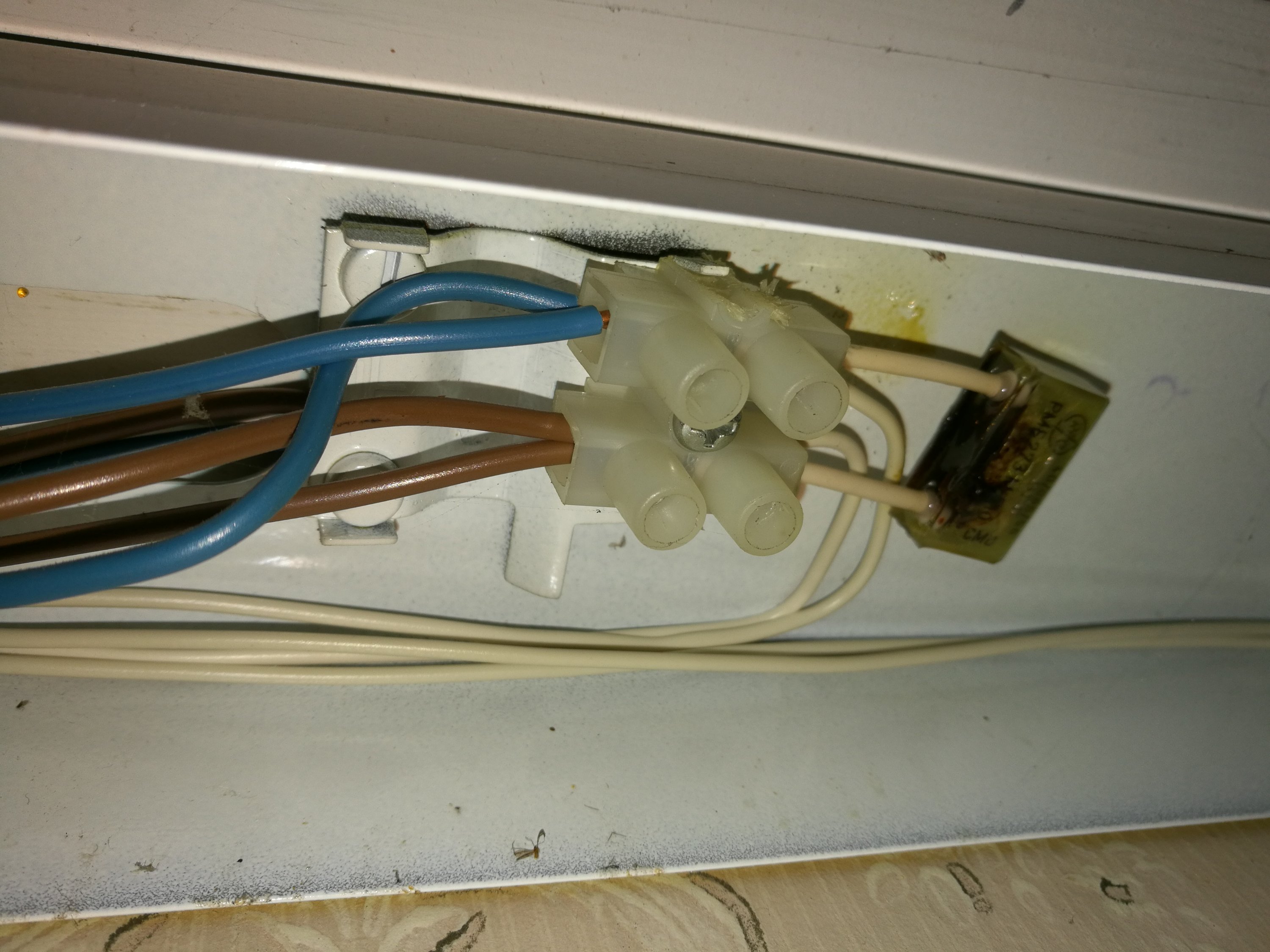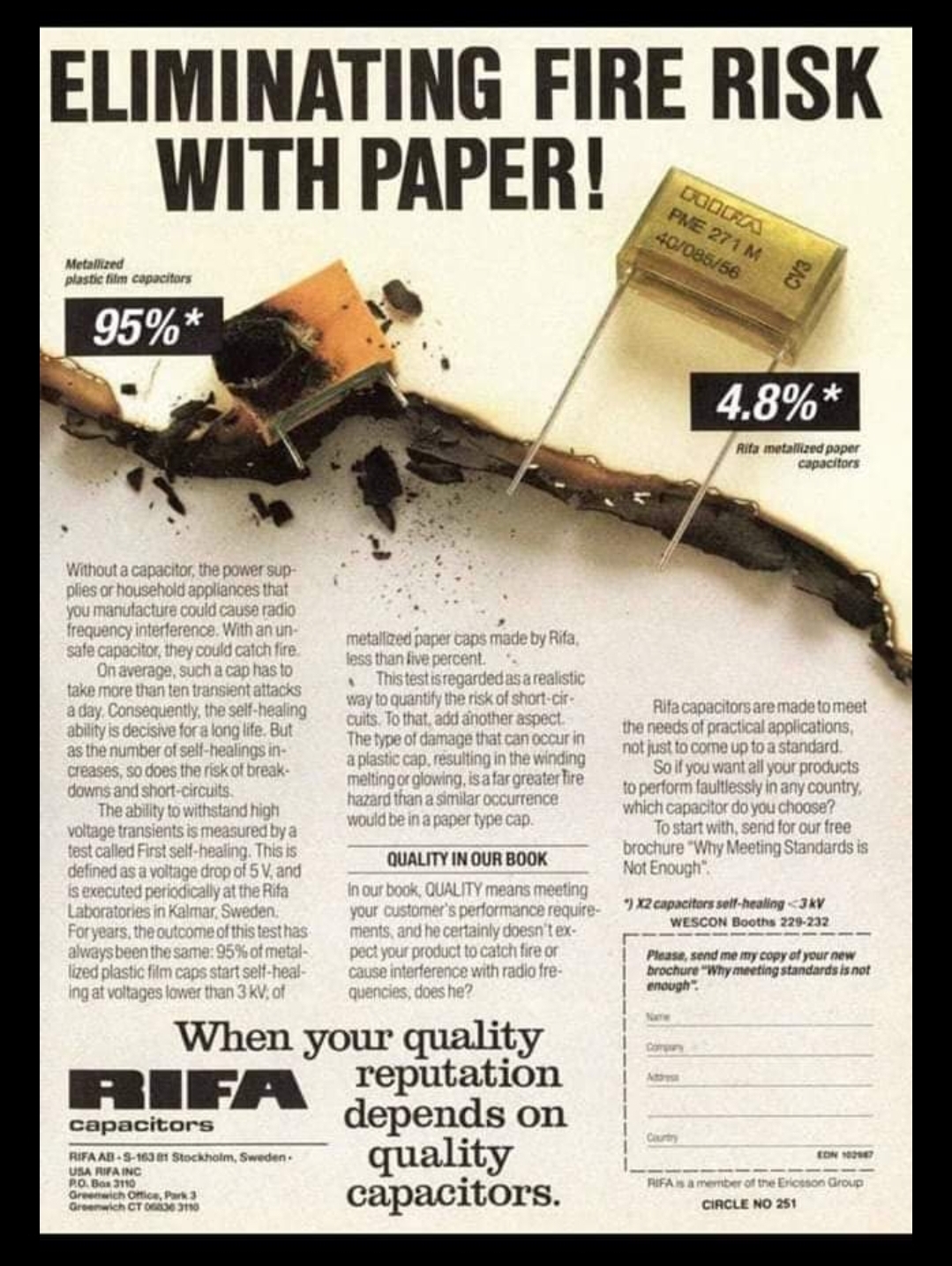Very many electrical equipment and fluorescent lamps powered from 230V AC have a filtering capacitor on power input between live and neutral. This is typically there for interference suppressing. That capacitor is normally X rated “self healing” type, but they can sometimes fail. When they fail their case starts turning black, and they can start putting out smoke – and potentially start a fire. Especially certain paper capacitor models made by RIFA.
RIFA is Swedish and stands for RadioIndustriernas FabriksAktiebolag, which translates into The Radio Industry’s Manufacturing Incorporated. In German vintage audio forums, these RIFA caps are known as “Knallfrosch”, which translates to firecracker. This is a common problem with vintage computers. Especially in the power supplies. Just get an old machine, turn it on, and boom! Magic smoke! The PME labeled caps were used extensively in older Tektronix switching power supplies. RIFA PME capacitors is pretty much the electronic version of Surströmming. Both come from Sweden, and both explode and stink.
Evox Rifa Metallized Paper X2 Capacitors PME271M
https://www.hificollective.co.uk/components/evox-rifa-pme271m.html
They are classified as X2 capacitors. X2 capacitors are used in positions where a failure of the capacitor would not expose anybody to danger of electric shock.
Failing RIFA safety capacitors
https://www.youtube.com/watch?v=GDTuHDsHHFA
RIFA AC Filter Capacitor Blowup
https://www.youtube.com/watch?v=njbwdbcfXjc
An attempt to capture the failure of a RIFA AC filter capacitor in a TRS-80 Model II Microcomputer.
Rifa Capacitor Fun
https://www.youtube.com/watch?v=8YhS-k1TRFA
In this video I demonstrate why I ALWAYS replace Rifa capacitors when I am repairing vintage machines.
Do not watch this video if you have a nervous disposition.
RIFA capacitor Blows up! while playing Revox B790
https://www.youtube.com/watch?v=YtGdWZ93-uQ
An old RIFA capacitor blows up while playing a record on Revox B790.
Why Do Rifa Capacitors Fail?
https://hackaday.com/2023/04/01/why-do-rifa-capacitors-fail/
Anyone who works with older electronic equipment will before long learn to spot Rifa capacitors, a distinctive yellow-translucent component often used in mains filters, that is notorious for failures. It’s commonly thought to be due to their absorbing water, but based upon [Jerry Walker]’s long experience, he’s not so sure about that. Thus he’s taken a large stock of the parts and subjected them to tests in order to get to the bottom of the Rifa question once and for all.
Rifa Capacitor Fun Follow Up
https://www.youtube.com/watch?v=TB5FL3vziko
EEVblog #1183 – RIFA Madness (Schaffner Repair)
https://www.youtube.com/watch?v=XAbrU17hLTM&t=548s
Repairing the Schaffner NSD200E Mains Interference Simulator.
And the dangers of bad mains filters capacitors, and RIFA brand in particular.
How ironic! They were advertised as a very safe capacitor type once.
Ohhhhhh this did NOT age well.
A bit like the Rifas themselves.
Now there is even joke:
RIFA = Random Interval Fire Autostarter
Ah Rifa madness. To think some reputable suppliers still have them.
How to fix a device with failed or soon failing RIFA filter capacitor between mains wires:
Replace it with a newer (not Rifa) X2 capacitor of the same capacitance and equal or higher voltage rating.
And it is not only the paper capacitors that fail when they get old…
EEVblog 1486 – What you DIDN’T KNOW About Film Capacitor FAILURES!
https://www.youtube.com/watch?v=ikp5BorIo_M
You might think you know how film capacitors fail and degrade in capacitance over time – self-healing due to surges, right? WRONG!
Metallized Film Capacitor Lifetime Evaluation and Failure Mode Analysis
https://cds.cern.ch/record/2038610/files/45-56-Gallay.pdf


27 Comments
Tomi Engdahl says:
https://www.hunker.com/13408990/differences-in-x1-x2-y1-and-y2-capacitors
Tomi Engdahl says:
https://www.allaboutcircuits.com/technical-articles/safety-capacitor-class-x-and-class-y-capacitors/
Tomi Engdahl says:
https://electronics.stackexchange.com/questions/587088/safety-capacitors-is-it-ok-to-fit-an-x1-in-place-of-an-x2
Tomi Engdahl says:
From https://www.facebook.com/groups/VintageElectronicTestEquipment/permalink/6147976141986193/
“I’m not sure I’d call it a reliability problem when an electronic component fails after 30-50 years. Lots of the electronics you buy new today fail within 30-50 months!”
Tomi Engdahl says:
Failing RIFA safety capacitors
https://www.youtube.com/watch?v=GDTuHDsHHFA
In this video I’ll explain the details about safety capacitors, how they are used, X and Y class ratings, and why older RIFA safety capacitors need to be replaced. Tips on component desoldering too.
Tomi Engdahl says:
How to use Safety Capacitors – What are they?
https://www.youtube.com/watch?v=fQSlo1zmAlA
This video is about Safety Capacitors and how to use them and what they are. I’ll talk about the difference of an X and Y capacitor. There are X1, X2, and Y1, and Y2 capacitors sometimes referred to as RFI capacitors.
Tomi Engdahl says:
From https://www.facebook.com/groups/VintageElectronicTestEquipment/permalink/6336764229774049/
I wouldn’t buy NOS RIFAs, but the new ones are pretty good.
Magic Smoke capsules
Love the smell of Rifa’s in the morning..
The main problem with old stock RIFA safety caps is that they used a bad epoxy encapsulation that allows moisture ingress over time and accelerates the degradation of the “self healing” caps. If the epoxy is not yellow and cracked you can probably get a decade or two out of even NOS RIFA caps, but they will eventually fail, and the epoxy flaw means that they will fail sooner and more spectacularly than modern equivalents.
Maarten says:
It’s very likely a myth that new ones are any (or at best much) better. Even their plastic encapsulated types fail, be it at a somewhat slower (not lower) rate. If they ever changed their epoxy recipe, they still won’t last any longer than their Wima MP3 epoxy cousins, which fail comparable to the plastic encapsulated RIFA’s. The main problem is that they’re cheapish molded impregnated paper capacitors, which have a limited life span by definition. They will last anywhere from just beyond the warranty of the equipment up to 40 years if never powered down and used in warm and dry conditions. New old stock ones, even if only 5 to 10 years old, can and will fail depending on storage conditions.
Tomi Engdahl says:
The infamous RIFA Miniprint moulded capacitors.
They’re good for about 40 years but then they go bang! Still being made and for some applications still the only one available.
the problem is the resin they used to mould the foil package. Over time it develops tiny cracks which allow moisture to enter and cause even more cracks, until eventually the foil gets shorted and … boom
more info on these: https://hackaday.com/2023/04/01/why-do-rifa-capacitors-fail/
Source:
https://m.facebook.com/groups/ElectronicParts/permalink/2224853751037281/
Tomi Engdahl says:
Also other caps can fail:
Those yellow 250/275V film caps they love to die so that their capacitance value drops considerable. When the capacitance value is just half or third of nominal value devices that use them in transformerless power supplies usually stop working properly.
I’ve found this problem on various devices. I usually check it first when I see it.
Tomi Engdahl says:
About cracking unused rifa caps:
Common problem with many synthetic materials is that the component which allows the plastic to be moldable, (softener) continues to evaporate over the years, schrinking the volume and making it more brittle in the process. The metallic inside however would not schrink. Something has to give….
Tomi Engdahl says:
those are the crash & burn firestarter caps, they are renowned for catching on fire. You should replace with another type of X rated film cap – X2 is the lower rating so you could also use an X1 rated cap. Make sure that whatever cap you get is X rated, normal film cap is not safe for that position
X1 and X2 capacitors are safety-rated to be placed line-to-line or line-to-neutral. X1 are pulse tested to 4kV; X2 to 2.5kV. They are “self-healing,” in that an internal arc will vaporize the metal around the internal short and open it back up.
Tomi Engdahl says:
Needs to be replaced with same type or exact equivalent for safety. SH is self-healing.
Or smoke-hissing
Tomi Engdahl says:
https://www.facebook.com/groups/ElectronicParts/permalink/2238800762975913/
Replace wit X or X2. These are RIFA ~25-year delay smoke bombs PME 271 M. They go with a stink and tar but without fire. Lore says the potting material temperature coefficient of expansion doesn’t match that of the capacitor bobbin, forming cracks, humidiity enters and accelerates evil processes. New KEMET PME can be used, in 25 years we talk again.
Tomi Engdahl says:
Those are X rated safety capacitors. Those are Rifa paper capacitors famous for often failing after some decades of use letting out smoke. They should be replaced with an X rated new safety capacitor with same capacitance and same (or higher) voltage rating. The new capacitors should have X2 or X1 rating (X1 being better).
Tomi Engdahl says:
smoke from cap
https://www.google.com/url?sa=t&source=web&rct=j&opi=89978449&url=https://m.youtube.com/watch%3Fv%3DnjbwdbcfXjc&ved=2ahUKEwiQlsbd8uOAAxUY7qQKHQhODCQQwqsBegQIDBAG&usg=AOvVaw0BNojaUTrGg4mUdCMhhXgc
Tomi Engdahl says:
RIFA = Random Interval Fire Autostarter

Tomi Engdahl says:
Safety capacitors, designed to fail open. One thing they never considered is that thst vintage series of RIFA safety csp developped micro cracks in potting material moisture gets in, it heats up, goes up in smoke. Apparently newer RIFA safety cap do not suffer same fate (?) To replaced you need to know X cap (Across power line) or Y (from line to gnd) X2 and Y2 would be a good replacement.
Tomi Engdahl says:
Replace Immediately Fire Ahead.
(and I can smell this photo)
Tomi Engdahl says:
Refuse to Implement in Future Applications
Tomi Engdahl says:
They are the dreaded Rifa PME type (MEtallized Paper) class X or X2 (rated for connection straight across mains). Alternatively class Y or Y2 if they are to be connected between mains and ground. You will want to replace them with a metallized plastic foil type of the same class. The exact capacitance is usually not critical.
so i can replace it with a cap X 2
Only if it says X2 on it. If it says Y/Y1/Y2/Y3 then you need to replace it with a Y type.
Need to see the markings on the top to see whether it is an X-type or a Y-type. You need to replace it with the same type and they are NOT interchangeable. They are safety caps that are designed to fail in a particular mode, and the X and Y are opposite modes to each other.
One designed for series use in mains, and one across the mains.
Fortunately, TDK/Epcos make polypropylene X and Y safety caps that fit typical Rifa mountings, and they last MUCH longer than these awful things.
Tomi Engdahl says:
Tuota Rifaa on häiriösuotokonkkana suoraan verkkovirrassa. Yleensä vikaantuminen on vain ajan kysymys missä funktion muuttujina on käyttötunnit jännitteellä, seisotustunnit, ympäristön lämpötila ja ilmankosteus, ylijännitepiikit, tuuri, AC vs DC, jne.
Tarkkoja speksejä en muista, mutta taisi olla 250V luokiteltu komponentti, mikä nyt ei oikeen jätä turvamarginaalia suomisähköillä. Mutta näitä on kyllä 110VAC maan laitteissakin paukkunut.
Aika laajasti tunnettu ja dokumentoitu ongelma, elikkäs netistä löytää videota ja tekstiä.
Tomi Engdahl says:
Näyttää pahamaineiselle Rifa paperikonkalle, joista yleisimmin näkemäni koot on olleet 0.1, 0.22 ja 0.47 uF
Tomi Engdahl says:
RIFA Capacitors – Quick Look at why you should remove them
https://www.youtube.com/watch?v=j6oGHZ4RG-U
In this video we briefly discuss how to identify the RIFA capacitors in older electrical equipment, show how they fail and discuss why we recommend replacing them if you find them in equipment you are repairing.
Tomi Engdahl says:
EEVblog #1183 – RIFA Madness (Schaffner Repair)
https://www.youtube.com/watch?v=XAbrU17hLTM
Repairing the Schaffner NSD200E Mains Interference Simulator.
EEVblog #1183 – RIFA Madness (Schaffner Repair)
https://www.dailymotion.com/video/x7nremq
Tomi Engdahl says:
https://hackaday.com/2023/04/01/why-do-rifa-capacitors-fail/
Tomi Engdahl says:
Ugh. No. NEVER these. Rifa and TDK/EPCOS do polypropylene equivalents of the exact size and leg pitch that will last a lifetime.